高三英语试卷讲评课教案
- 格式:doc
- 大小:16.50 KB
- 文档页数:4
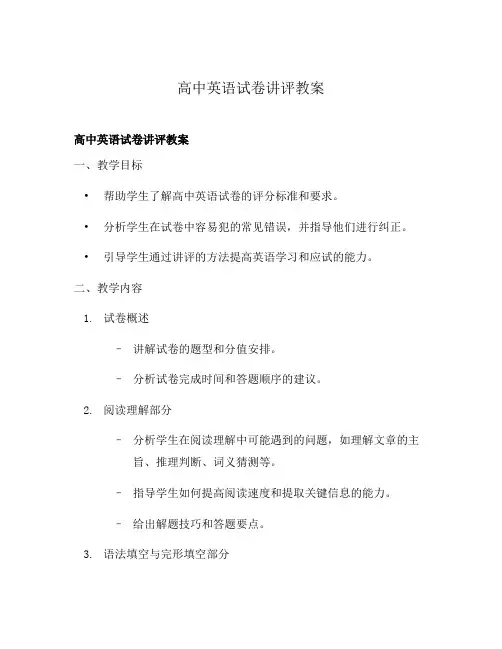
高中英语试卷讲评教案高中英语试卷讲评教案一、教学目标•帮助学生了解高中英语试卷的评分标准和要求。
•分析学生在试卷中容易犯的常见错误,并指导他们进行纠正。
•引导学生通过讲评的方法提高英语学习和应试的能力。
二、教学内容1.试卷概述–讲解试卷的题型和分值安排。
–分析试卷完成时间和答题顺序的建议。
2.阅读理解部分–分析学生在阅读理解中可能遇到的问题,如理解文章的主旨、推理判断、词义猜测等。
–指导学生如何提高阅读速度和提取关键信息的能力。
–给出解题技巧和答题要点。
3.语法填空与完形填空部分–指导学生掌握常见的语法知识和词汇用法。
–分析学生容易犯的常见错误,如动词时态、主谓一致、词形变化等。
–引导学生通过语境判断、选项排除等方法解题。
4.短文改错部分–分析学生在短文改错中容易犯的错误类型,如语法错误、拼写错误、词汇用法错误等。
–提醒学生注意标点符号、大小写、时态等方面的错误。
–解释评分标准和扣分要点。
5.书面表达部分–分析学生在书面表达中可能存在的问题,如句子结构、用词准确性、逻辑连贯性等。
–给出写作技巧和范文参考,指导学生如何提高写作水平。
–讲解评分标准和常见的扣分项。
三、教学方法•讲解分析法:通过解析试卷题目的设计和解题思路,引导学生理解题意和解题技巧。
•互动提问法:通过提问学生容易出错的地方,帮助他们准确理解知识点和答题要求。
•案例分析法:选取一些学生的试卷进行分析和评讲,让学生从错误中学习和充分认识标准答案的要求。
四、教学步骤1.介绍教学目标和教学内容。
2.带领学生回顾试卷的题型和分值安排。
3.以阅读理解部分为例,进行示范讲解,引导学生理解解题思路和答题要求。
4.分组活动:学生分组讨论并分析其他题型中的常见错误和解题技巧。
5.案例分析:随机选取几份试卷进行评讲,引导学生理解评分标准和答题要点。
6.解答学生的疑问,针对性提出改进建议和学习方法。
7.总结教学要点和方法,鼓励学生通过反思总结来提高应试能力。
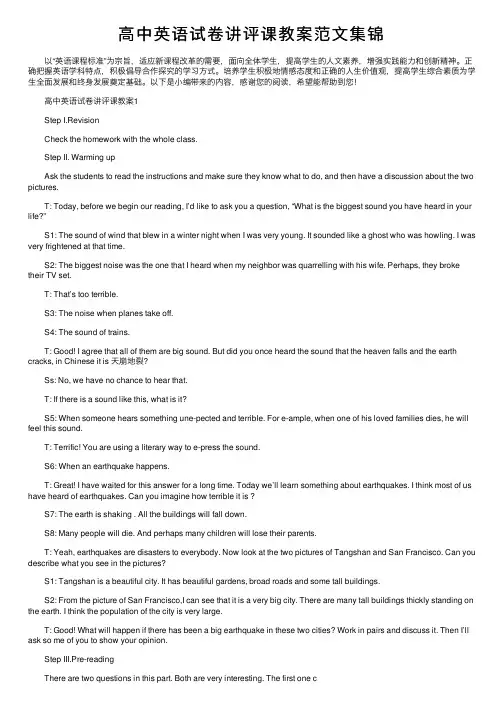
⾼中英语试卷讲评课教案范⽂集锦以“英语课程标准”为宗旨,适应新课程改⾰的需要,⾯向全体学⽣,提⾼学⽣的⼈⽂素养,增强实践能⼒和创新精神。
正确把握英语学科特点,积极倡导合作探究的学习⽅式。
培养学⽣积极地情感态度和正确的⼈⽣价值观,提⾼学⽣综合素质为学⽣全⾯发展和终⾝发展奠定基础。
以下是⼩编带来的内容,感谢您的阅读,希望能帮助到您!⾼中英语试卷讲评课教案1Step I.RevisionCheck the homework with the whole class.Step II. Warming upAsk the students to read the instructions and make sure they know what to do, and then have a discussion about the two pictures.T: Today, before we begin our reading, I’d like to ask you a question, “What is the biggest sound you have heard in your life?”S1: The sound of wind that blew in a winter night when I was very young. It sounded like a ghost who was howling. I was very frightened at that time.S2: The biggest noise was the one that I heard when my neighbor was quarrelling with his wife. Perhaps, they broke their TV set.T: That’s too terrible.S3: The noise when planes take off.S4: The sound of trains.T: Good! I agree that all of them are big sound. But did you once heard the sound that the heaven falls and the earth cracks, in Chinese it is 天崩地裂?Ss: No, we have no chance to hear that.T: If there is a sound like this, what is it?S5: When someone hears something une-pected and terrible. For e-ample, when one of his loved families dies, he will feel this sound.T: Terrific! You are using a literary way to e-press the sound.S6: When an earthquake happens.T: Great! I have waited for this answer for a long time. Today we’ll learn something about earthquakes. I think most of us have heard of earthquakes. Can you imagine how terrible it is ?S7: The earth is shaking . All the buildings will fall down.S8: Many people will die. And perhaps many children will lose their parents.T: Yeah, earthquakes are disasters to everybody. Now look at the two pictures of Tangshan and San Francisco. Can you describe what you see in the pictures?S1: Tangshan is a beautiful city. It has beautiful gardens, broad roads and some tall buildings.S2: From the picture of San Francisco,I can see that it is a very big city. There are many tall buildings thickly standing on the earth. I think the population of the city is very large.T: Good! What will happen if there has been a big earthquake in these two cities? Work in pairs and discuss it. Then I’ll ask so me of you to show your opinion.Step III.Pre-readingThere are two questions in this part. Both are very interesting. The first one can more or less reveal the students’ values; while the second one can enlarge their imagination. No matter what their answers are, as long as they have given careful thoughts to the situations, their answers should be good.T: Now, let’s look at the pictures. What are the predictions of an earthquake?S1: Before an earthquake animals will become nervous. Cows, pigs, horses and dogs will be upset. And people can see mice running about. If the earthquake happens during winter, people can even see snakes.T: Terrific! Where did you get this knowledge?S1: From geography. I like it.T: good. Sit down please.S2: Madam, I don’t know the meaning of the picture with two women.T: It doesn’t matter. You will know it soon after reading our te-t. OK. Imagine there is an earthquake now, and your home is shaking, at this moment you have no time to take any other things but one, what will it be?S3: I’ll take all my money. People can’t live without money.S4: I will take as much water as possible. Because it is said that people can keep alive for nearly 7 days by drinking without any foodS5: In that case, I’d rather take some apples, so that besides drinking, I can also eat.S6: I will carry my grandma. She is my most loved person in this world. She brought me up.T: What a dutiful child you are! I’m very glad to hear that. Sit down please! It seems that all of you know what you should do during an earthquake. OK. Let’s read our te-t, and see what it tells us.Step IV.ReadingIn this part, teacher should ask the students to read the passage quickly for the first time to get the general idea of the passage. Ask them to pay attention to the first sentence of each paragraph. This can help them finish e-ercise3 in Comprehention. It is about the main idea of each paragraph. Then ask them to read the te-t again carefully to obtain some details. Before reading for the second time, show some questions on the screen, and let the students read the questions first. These questions can guide them to have a good understanding about the te-t. They can also make preparations for E-s1-2,which are about details.SkimmingT: At first I’d like to read the te-t quickly to get the general idea of the article. While reading, you should pay attention to the sentence of each paragraph.T: Have you got the general idea of the te-t?Ss: Yes.T: What is it?S1: There is no quick answer to this question . Are you suggesting us that the general idea is the mi-ture of the first sentences of each paragraph?T: Sure.S1:OK. That’s easy. The main idea of the passage is some signs of the earthquake, and what would happen during the quake.T: Good, sit down please. In fact, while we are answering the questions, we have involved the sequence, the functional item for this unit. (Teacher writes the word on the blackboard ) Do you understand the meaning of the word?Ss: No.T: Sequence means the order of the events. It can tell us which event happens first, and which happens later. Do you know the sequence that is used in our te-t?S3: Yes. At first, the te-t tells us something that happened before the quake, then it tells us the things that happenedduring the quake and at last it tells us the things that happened after the earthquake.T: Quite right! Now please look at the screen, these are the first sentences of each paragraph. Read them and think if they are the main idea of the te-t. If necessary, you may make some changes to make more e-act.Teacher shows the screen and gives a little time to think it over.1.Strange things were happening in the countryside in the northeast Hebei.2.The disaster happened and caused a lot of loss.3. All hope was not lost.Careful readingT: Now, it’s time for us to read the te-t carefully. But before reading, you should read some questions first. These questions may help you get some information quickly and easily. Now look at the screen, and read the questions.Show on the screen1.What natural signs of a coming disaster were there?2.Can you think of some reasons why these signs weren’t noticed?3.What events probably made the disaster worse?4.What situations probably made the disaster worse?5.How were the survivors held?Step V. E-tensionShow the questions on the screen.1.From whose point of view are events described? How do you know?2.What is the mood of this passage? How is it created?3.Why do you think the writer chooses to e-press his feelings about the quake rather than simply reporting what had happened?4.Why is the title A NIGHT THE EARTH DIDN’T SLEEP?5.What does the sentence “Slowly, the city began to breathe again.” mean?Answers:1. He uses third-person to describe the quake. His description is very objective. For e-ample, the second sentence in the third paragraph. The writer says: “Everywhere they looked nearly everything was destroyed.” The writer uses they instead of we.2.The mood is serious and a bit sad. It is created by giving details of how many people and animals were killed or injured, and how many buildings were destroyed.3.Although the writer was not there, he felt sad for the people of Tangshan. He knows that some personal feelings will make the reading more interesting.4.I think the reason is that, as usual, night is the time to sleep, and night should be safe and quiet. But that night everything changed. The writer uses A NIGHT THE EARTH DIDN’T SLEEP as a title to show how terrible and how unusual the night was.5.Here we can see that the writer compared the city to a person who suffered a lot in the disaster. He felt her pain, and he worried about her. So when he said that people came to help her, we can feel his feelings to the city. The city will not die, she has hope and she can recover from the pain.Step VI ComprehendingAnswers to E--1-31.1. C2. E3.B4.D5.A2.1. The walls of the villages wells had cracks in them.2 .Roads got huge cracks3. Brick buildings were destroyed.4. The army helped the survivors.5. Shelters were put up for those with no homes.3.1. Strange things were happening in the countryside in northeast Hebei..1.The disaster happened and caused a lot of loss.2.All hope was not lost.Step VII Homework课后反思:总体感觉上,本节课上得⽐较成功,⼼情愉快。
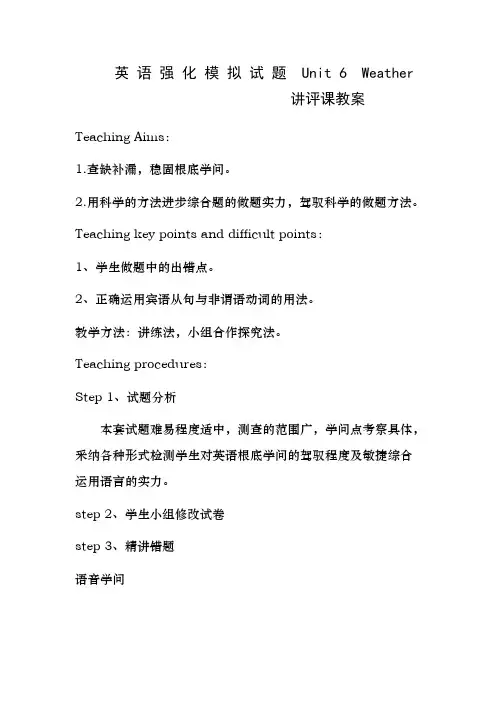
英语强化模拟试题 Unit 6 Weather讲评课教案Teaching Aims:1.查缺补漏,稳固根底学问。
2.用科学的方法进步综合题的做题实力,驾驭科学的做题方法。
Teaching key points and difficult points:1、学生做题中的出错点。
2、正确运用宾语从句与非谓语动词的用法。
教学方法:讲练法,小组合作探究法。
Teaching procedures:Step 1、试题分析本套试题难易程度适中,测查的范围广,学问点考察具体,采纳各种形式检测学生对英语根底学问的驾驭程度及敏捷综合运用语言的实力。
step 2、学生小组修改试卷step 3、精讲错题语音学问5道小题分别考察了元音字母u,字母组合ea,ar 及辅音字母ch. S 的发音。
语音题的考核重点还是在元音上。
备考建议: 驾驭根底的发音规则,多朗读,多归纳。
语言学问运用:(A)8.--- Are you satisfied with her answer?---- Not at all, it couldn’t have been _____.A. worseB. so badC. tooD. very高考链接How are your recent trip to Sichuan?---I have never had ______ one before.A. a pleasantB. a more pleasantC. a most pleasantD. the most pleasant【命题动向】考察否认词与比拟级的连用表确定。
解析:句意:“从来没有这么开心过。
”否认词never与a more pleasant 连用,表示特别开心,等于最高级。
the most pleasant 是特指,须要有比拟的范围。
因此选B.(A)12. The library is ______ the reading room.A. twice as big asB. twice as bigger asC. twice as big thanD. as twice big as高考链接The playground is ______that one.(2014)A. three times as big asB. three times bigger asC. three time bigger asD. as three times big as【命题动向】考察倍数表达法。
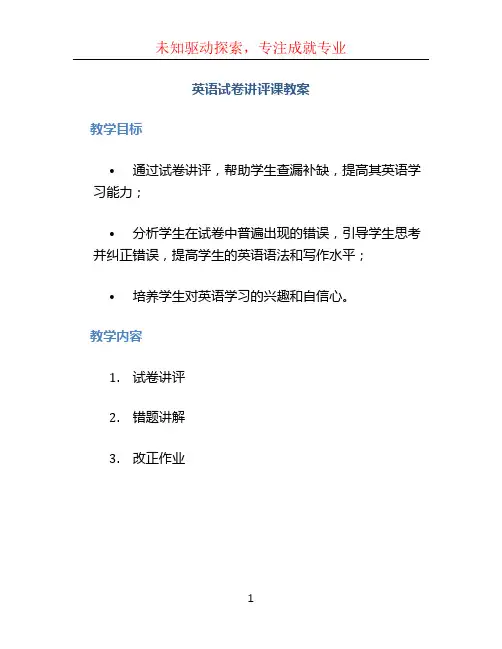
英语试卷讲评课教案教学目标•通过试卷讲评,帮助学生查漏补缺,提高其英语学习能力;•分析学生在试卷中普遍出现的错误,引导学生思考并纠正错误,提高学生的英语语法和写作水平;•培养学生对英语学习的兴趣和自信心。
教学内容1.试卷讲评2.错题讲解3.改正作业教学步骤第一步:试卷讲评(10分钟)1.学生交出试卷;2.教师快速浏览试卷,做一些整体评价;3.教师列举一些学生普遍出现的错误,如:动词时态的误用、名词单复数的错误、冠词的使用等;4.引导学生思考和解答,纠正错误。
第二步:错题讲解(30分钟)1.教师根据试卷,选择一些学生普遍错的题目进行讲解;2.教师解答学生提出的问题,并给出相应的解析;3.学生记录讲解的重点内容。
第三步:改正作业(20分钟)1.学生拿出最近一次作业;2.教师逐一让学生上台将自己的错题进行讲解;3.教师和其他学生进行点评,并给出修改建议。
第四步:总结反思(10分钟)1.教师和学生一起总结学习内容,复习重点知识;2.学生发表个人感受,教师给予鼓励和肯定;3.教师布置下一次作业。
教学资源•学生试卷•错题解析材料•黑板/白板•讲义•笔记本电脑或投影仪(可选)教学评估•学生在课堂上能积极参与讨论,提出问题并解答问题;•学生对错题和讲解内容进行了记录和总结;•学生在下一次作业中能够纠正之前犯过的错误。
参考资料•《英语学习指导手册》•《英语语法详解》•《英语写作范文集》这个教案是一堂关于英语试卷讲评的课程计划。
通过分析学生在试卷中的错误,并进行针对性讲解和纠正,旨在帮助学生提高他们的英语学习能力和英语应试技巧。
同时,通过这个课程,培养学生对英语学习的兴趣和自信心。
通过试卷讲评,学生能够了解自己在哪些方面存在问题。
教师可以列举一些学生普遍出现的错误,然后引导学生思考和解答,从而帮助他们纠正错误。
同时,教师可以选择一些学生普遍错的题目进行讲解,解答学生提出的问题,并给出相应的解析,帮助学生更好地理解和掌握知识点。
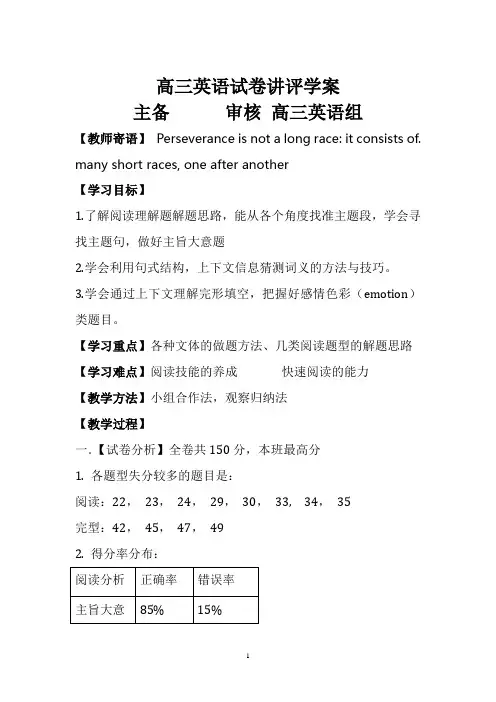
高三英语试卷讲评学案主备审核高三英语组【教师寄语】Perseverance is not a long race: it consists of. many short races, one after another【学习目标】1.了解阅读理解题解题思路,能从各个角度找准主题段,学会寻找主题句,做好主旨大意题2.学会利用句式结构,上下文信息猜测词义的方法与技巧。
3.学会通过上下文理解完形填空,把握好感情色彩(emotion)类题目。
【学习重点】各种文体的做题方法、几类阅读题型的解题思路【学习难点】阅读技能的养成快速阅读的能力【教学方法】小组合作法,观察归纳法【教学过程】一.【试卷分析】全卷共150分,本班最高分1. 各题型失分较多的题目是:阅读:22,23,24,29,30,33, 34,35完型:42,45,47,492. 得分率分布:二.Group DiscussionRequirements:1)First have a one-to-one discussion and then you canturn to other students.2) Group leaders:①Control the time and process.②Mark the question that can’t be solved.3)Try to find out the related key sentences.22. 解析23.解析24.解析29解析30解析33解析34. 解析35解析三.链接高考当堂达标1. When I first became a reporter I knew a man who gave up a very well paid respectable job at the Daily Telegraph to go and edit a small weekly newspaper. At the time I was astonished by what appeared to me to be his completely abnormal (反常的) mental state. How could anyone turn his back on Fleet Street in central London for a small local area? I wanted to know.The underlined phrase "turn his back on" (paragraph 6)most probably means .A. leave forB. return toC. give upD. rely on2. In fact, when it comes to the art of war, ants have no equal. They are completely fearless and will readily take on a creature much larger than themselves, attacking in large groups and overcoming their target. Such is their devotion to the common good of the colony that not only soldier ants but also worker ants will sacrifice their lives to help defeat an enemy.What does the underlined expression "take on" inParagraph 3 mean?A. Accept.B. Employ.C. Play with.D. Fight against.四. Possible version:In the picture, we can see an old farmer, whose back is already bent, standing in his rice field bare-footed and pulling up the young rice plants by half an inch one after another.This is a well-known story of an ancient Chinese idiom. The farmer thought his rice plants grew too slowly, so he dashed to the field and began pulling the rice plants to help them grow. However, all the rice plants died the next day. The moral of the story is that being anxious for success but going against the objective law of the development of things will surely end in failure.This idiom is a bit like the English saying “Haste makes waste”. People now use it to describe the behavior of those who are too eager to get something done only to make it worse.五What I have learned in this period1.____________________________________________________2.____________________________________________________3.____________________________________________________六.Homework1. Put the wrong topic to arrange to error set .(请把错的题整理到错题集上)2. 学习反思与收获学情分析教学对象是乡镇普通高中学生,英语语言基础比较差,学习被动,主动性和兴趣不高,但是大多数学生都有提高英语成绩的愿望。
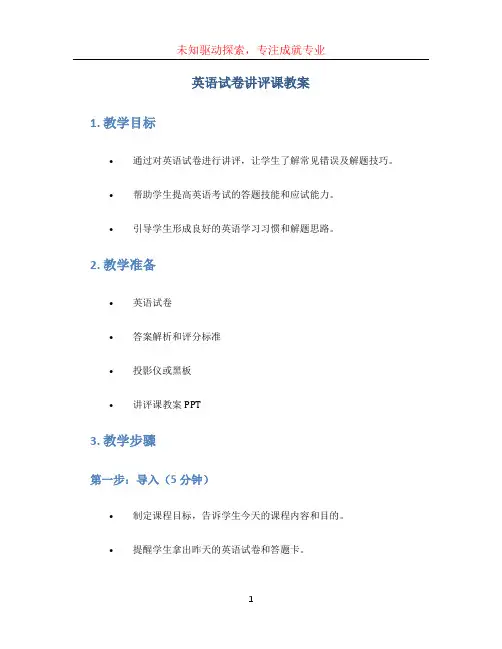
英语试卷讲评课教案1. 教学目标•通过对英语试卷进行讲评,让学生了解常见错误及解题技巧。
•帮助学生提高英语考试的答题技能和应试能力。
•引导学生形成良好的英语学习习惯和解题思路。
2. 教学准备•英语试卷•答案解析和评分标准•投影仪或黑板•讲评课教案PPT3. 教学步骤第一步:导入(5分钟)•制定课程目标,告诉学生今天的课程内容和目的。
•提醒学生拿出昨天的英语试卷和答题卡。
2.1. 第一部分:听力理解(5分钟)•打开PPT,展示第一部分的听力题目。
•解析前几道听力题的做题技巧和常见错误,引导学生如何通过听力材料选出正确答案。
•通过投票或提问,与学生互动讨论。
2.2. 第二部分:阅读理解(10分钟)•展示第二部分的阅读理解题目和文章。
•解析几道阅读理解题的解题思路和常见错误,教授学生如何从文章中找到答案的方法和技巧。
•与学生互动,鼓励他们积极发言和提问。
2.3. 第三部分:完形填空(10分钟)•展示第三部分的完形填空题目和文章。
•解析几道完形填空题的答题技巧和常见错误,让学生理解如何从上下文中推测缺失的单词或短语。
•与学生一起分析文章的语境和主题。
•对本节课的内容进行总结,强调学习要点和解题技巧。
•提示学生回顾自己在试卷中的错误,找出原因和改进方法。
•鼓励学生提出问题和建议,加强课堂互动。
4. 课后作业•要求学生认真批阅自己的试卷,对照答案解析找出错误,并进行纠正。
•对于解题错误的部分,要求学生重新做题或查找相关资料进行复习。
•鼓励学生积极参加英语角或其他英语学习活动,提高口语和听力能力。
5. 教学反思通过本节课的讲评,学生对于英语试卷中的常见错误和解题技巧有了更深入的了解。
课堂上的互动也提高了学生的参与度和思考能力。
在课后作业中,学生有机会反思自己的错误,并进行复习和提升。
需要进一步改进的地方是,增加多样化的教学活动,如小组讨论,游戏和角色扮演等,以激发学生学习英语的兴趣和积极性。
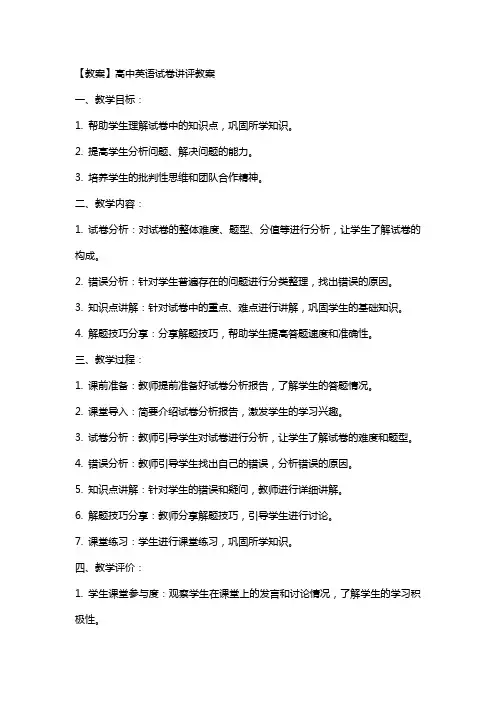
【教案】高中英语试卷讲评教案一、教学目标:1. 帮助学生理解试卷中的知识点,巩固所学知识。
2. 提高学生分析问题、解决问题的能力。
3. 培养学生的批判性思维和团队合作精神。
二、教学内容:1. 试卷分析:对试卷的整体难度、题型、分值等进行分析,让学生了解试卷的构成。
2. 错误分析:针对学生普遍存在的问题进行分类整理,找出错误的原因。
3. 知识点讲解:针对试卷中的重点、难点进行讲解,巩固学生的基础知识。
4. 解题技巧分享:分享解题技巧,帮助学生提高答题速度和准确性。
三、教学过程:1. 课前准备:教师提前准备好试卷分析报告,了解学生的答题情况。
2. 课堂导入:简要介绍试卷分析报告,激发学生的学习兴趣。
3. 试卷分析:教师引导学生对试卷进行分析,让学生了解试卷的难度和题型。
4. 错误分析:教师引导学生找出自己的错误,分析错误的原因。
5. 知识点讲解:针对学生的错误和疑问,教师进行详细讲解。
6. 解题技巧分享:教师分享解题技巧,引导学生进行讨论。
7. 课堂练习:学生进行课堂练习,巩固所学知识。
四、教学评价:1. 学生课堂参与度:观察学生在课堂上的发言和讨论情况,了解学生的学习积极性。
2. 学生练习成果:检查学生的课堂练习,评估学生的学习效果。
3. 学生反馈:收集学生的反馈意见,了解学生的学习需求。
五、教学资源:1. 试卷分析报告:教师自备。
2. 教学PPT:教师根据教学内容制作。
3. 课堂练习题:教师根据知识点设计。
4. 参考资料:教师提供相关参考资料,帮助学生巩固知识。
六、教学策略:1. 案例分析:通过具体案例,让学生了解试卷中的实际应用。
2. 小组讨论:引导学生进行小组讨论,培养学生的团队合作精神。
3. 互动提问:教师提问,学生回答,激发学生的思维活跃度。
4. 任务驱动:布置相关任务,让学生在实践中运用所学知识。
七、教学注意事项:1. 关注学生的个体差异,因材施教。
2. 鼓励学生提问,充分调动学生的积极性。
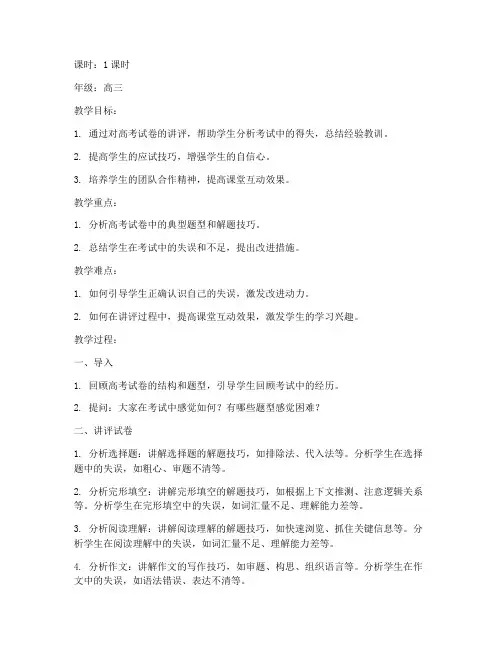
课时:1课时年级:高三教学目标:1. 通过对高考试卷的讲评,帮助学生分析考试中的得失,总结经验教训。
2. 提高学生的应试技巧,增强学生的自信心。
3. 培养学生的团队合作精神,提高课堂互动效果。
教学重点:1. 分析高考试卷中的典型题型和解题技巧。
2. 总结学生在考试中的失误和不足,提出改进措施。
教学难点:1. 如何引导学生正确认识自己的失误,激发改进动力。
2. 如何在讲评过程中,提高课堂互动效果,激发学生的学习兴趣。
教学过程:一、导入1. 回顾高考试卷的结构和题型,引导学生回顾考试中的经历。
2. 提问:大家在考试中感觉如何?有哪些题型感觉困难?二、讲评试卷1. 分析选择题:讲解选择题的解题技巧,如排除法、代入法等。
分析学生在选择题中的失误,如粗心、审题不清等。
2. 分析完形填空:讲解完形填空的解题技巧,如根据上下文推测、注意逻辑关系等。
分析学生在完形填空中的失误,如词汇量不足、理解能力差等。
3. 分析阅读理解:讲解阅读理解的解题技巧,如快速浏览、抓住关键信息等。
分析学生在阅读理解中的失误,如词汇量不足、理解能力差等。
4. 分析作文:讲解作文的写作技巧,如审题、构思、组织语言等。
分析学生在作文中的失误,如语法错误、表达不清等。
三、总结经验教训1. 引导学生总结自己在考试中的失误,分析原因。
2. 针对学生的失误,提出改进措施,如加强词汇积累、提高阅读理解能力等。
3. 强调团队合作的重要性,鼓励学生在学习过程中互相帮助、共同进步。
四、课堂互动1. 分组讨论:让学生分组讨论自己在考试中的失误,分享改进经验。
2. 问答环节:针对学生在考试中的失误,提出问题,让学生回答,加深对解题技巧的理解。
五、总结1. 强调考试讲评的重要性,鼓励学生认真对待每一次考试。
2. 鼓励学生树立信心,相信自己通过努力可以取得更好的成绩。
教学反思:1. 讲评过程中,关注学生的反馈,及时调整教学策略。
2. 提高课堂互动效果,激发学生的学习兴趣,提高教学效果。
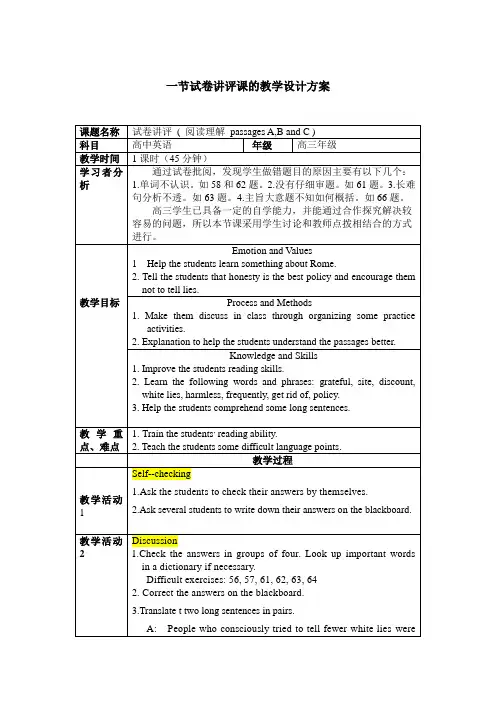
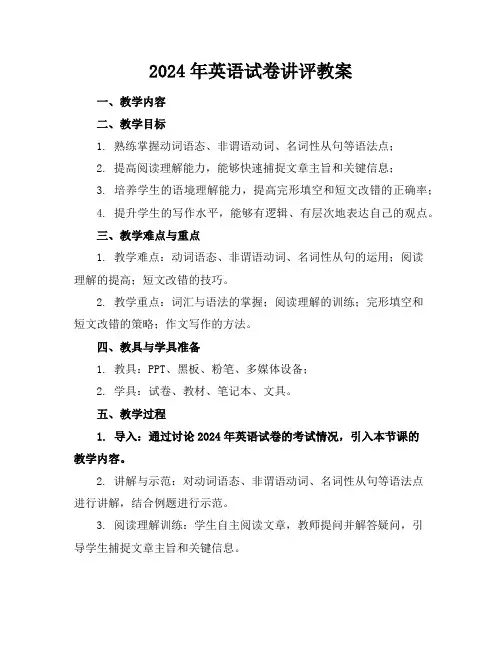
2024年英语试卷讲评教案一、教学内容二、教学目标1. 熟练掌握动词语态、非谓语动词、名词性从句等语法点;2. 提高阅读理解能力,能够快速捕捉文章主旨和关键信息;3. 培养学生的语境理解能力,提高完形填空和短文改错的正确率;4. 提升学生的写作水平,能够有逻辑、有层次地表达自己的观点。
三、教学难点与重点1. 教学难点:动词语态、非谓语动词、名词性从句的运用;阅读理解的提高;短文改错的技巧。
2. 教学重点:词汇与语法的掌握;阅读理解的训练;完形填空和短文改错的策略;作文写作的方法。
四、教具与学具准备1. 教具:PPT、黑板、粉笔、多媒体设备;2. 学具:试卷、教材、笔记本、文具。
五、教学过程1. 导入:通过讨论2024年英语试卷的考试情况,引入本节课的教学内容。
2. 讲解与示范:对动词语态、非谓语动词、名词性从句等语法点进行讲解,结合例题进行示范。
3. 阅读理解训练:学生自主阅读文章,教师提问并解答疑问,引导学生捕捉文章主旨和关键信息。
4. 完形填空与短文改错:学生独立完成练习,教师讲解解题策略,分析常见错误。
5. 作文指导:教师给出话题,指导学生进行构思,并进行写作训练。
6. 随堂练习:针对本节课的教学内容,设计练习题,让学生进行巩固。
六、板书设计1. 动词语态、非谓语动词、名词性从句的语法点;2. 阅读理解的技巧;3. 完形填空和短文改错的策略;4. 作文写作的方法。
七、作业设计1. 作业题目:(1)完成试卷中的词汇与语法练习;(2)阅读文章并回答问题;(3)完成一篇短文改错;八、课后反思及拓展延伸1. 反思:教师针对本节课的教学效果进行反思,调整教学方法,以提高教学效果。
2. 拓展延伸:推荐相关学习资料,鼓励学生进行课外学习,提高英语水平。
重点和难点解析1. 教学难点与重点的确定;2. 教学过程中的讲解与示范、阅读理解训练、完形填空与短文改错、作文指导;3. 板书设计;4. 作业设计。
一、教学难点与重点1. 教学难点与重点的确定应依据学生的实际情况和历年考试情况进行分析,确保教学内容的针对性和实用性。
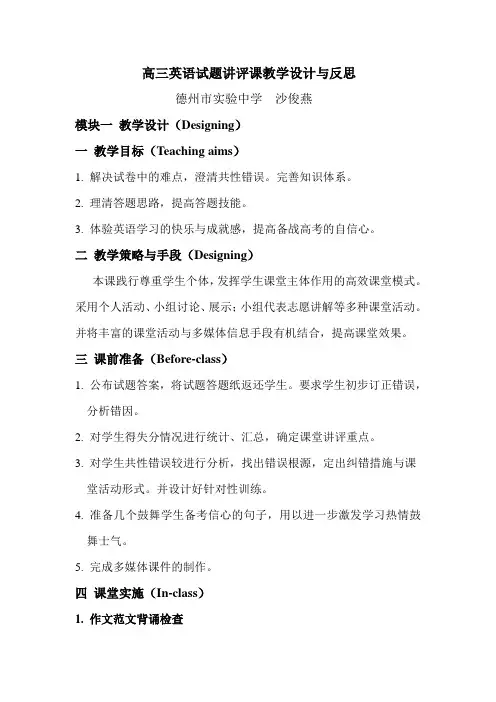
高三英语试题讲评课教学设计与反思德州市实验中学沙俊燕模块一教学设计(Designing)一教学目标(Teaching aims)1. 解决试卷中的难点,澄清共性错误。
完善知识体系。
2. 理清答题思路,提高答题技能。
3. 体验英语学习的快乐与成就感,提高备战高考的自信心。
二教学策略与手段(Designing)本课践行尊重学生个体,发挥学生课堂主体作用的高效课堂模式。
采用个人活动、小组讨论、展示;小组代表志愿讲解等多种课堂活动。
并将丰富的课堂活动与多媒体信息手段有机结合,提高课堂效果。
三课前准备(Before-class)1. 公布试题答案,将试题答题纸返还学生。
要求学生初步订正错误,分析错因。
2. 对学生得失分情况进行统计、汇总,确定课堂讲评重点。
3. 对学生共性错误较进行分析,找出错误根源,定出纠错措施与课堂活动形式。
并设计好针对性训练。
4. 准备几个鼓舞学生备考信心的句子,用以进一步激发学习热情鼓舞士气。
5. 完成多媒体课件的制作。
四课堂实施(In-class)1. 作文范文背诵检查利用多媒体课件展示范文关键词辅助学生背诵。
本环节为全班集体活动(group work)。
2.介绍考试结果简要介绍学生试卷完成情况。
包括满分,最高分,优秀和及格人数。
3.明确教学目标与课堂内容(教师做简要说明)让学生明确这节课要做些什么,需要达成怎样的目标。
所有课堂设计与活动都是实现三维学习目标的措施与手段。
4.试题讲解A.单项选择(individual work)。
学生独立思考解决单项选择中正答率为70%以下的题目(单选1.3.6.10)。
课件展示正答率、干扰项与考点。
独立思考2分钟后学生volunteer讲解题目。
有疑问的同学随时站起来质疑。
教师进一步点拨、总结。
然后当堂检测掌握情况,做巩固提升题(选取高考真题及2014高考预测)。
B.完形填空A篇(individual work)。
大声朗读完形A篇。
学生介绍文章大意,回答其他学生本篇题目中的疑问。
高中英语试卷讲评课教案范文集锦以“英语课程标准”为宗旨,适应新课程改革的需要,面向全体学生,提高学生的人文素养,增强实践能力和创新精神。
正确把握英语学科特点,积极倡导合作探究的学习方式。
培养学生积极地情感态度和正确的人生价值观,提高学生综合素质为学生全面发展和终身发展奠定基础。
以下是小编带来的内容,感谢您的阅读,希望能帮助到您!高中英语试卷讲评课教案1Step I.RevisionCheck the homework with the whole class.Step II. Warming upAsk the students to read the instructions and make sure they know what to do, and then have a discussion about the two pictures.T: Today, before we begin our reading, I’d like to ask you a question, “What is the biggest sound you have heard in your life?”S1: The sound of wind that blew in a winter night when I was very young. It sounded like a ghost who was howling. I was very frightened at that time.S2: The biggest noise was the one that I heard when my neighbor was quarrelling with his wife. Perhaps, they broke their TV set.T: That’s too terrible.S3: The noise when planes take off.S4: The sound of trains.T: Good! I agree that all of them are big sound. But did you once heard the sound that the heaven falls and the earth cracks, in Chinese it is 天崩地裂?Ss: No, we have no chance to hear that.T: If there is a sound like this, what is it?S5: When someone hears something une-pected and terrible. For e-ample, when one of his loved families dies, he will feel this sound.T: Terrific! You are using a literary way to e-press the sound.S6: When an earthquake happens.T: Great! I have waited for this answer for a long time. Today we’ll learn something about earthquakes. I think most of us have heard of earthquakes. Can you imagine how terrible it is ?S7: The earth is shaking . All the buildings will fall down.S8: Many people will die. And perhaps many children will lose their parents.T: Yeah, earthquakes are disasters to everybody. Now look at the two pictures of Tangshan and San Francisco. Can you describe what you see in the pictures?S1: Tangshan is a beautiful city. It has beautiful gardens, broad roads and some tall buildings.S2: From the picture of San Francisco,I can see that it is a very big city. There are many tall buildings thickly standing on the earth. I think the population of the city is very large.T: Good! What will happen if there has been a big earthquake in these two cities? Work in pairs and discuss it. Then I’ll a sk so me of you to show your opinion.Step III.Pre-readingThere are two questions in this part. Both are very interesting. The first one can more or less reveal the students’ values; while the second one can enlarge their imagination. No matter what their answers are, as long as they have given careful thoughts to thesituations, their answers should be good.T: Now, let’s look at the pictures. What are the predictions of an earthquake?S1: Before an earthquake animals will become nervous. Cows, pigs, horses and dogs will be upset. And people can see mice running about. If the earthquake happens during winter, people can even see snakes.T: Terrific! Where did you get this knowledge?S1: From geography. I like it.T: good. Sit down please.S2: Madam, I don’t know the meaning of the picture with two women.T: It doesn’t matter. You will know it soon after reading our te-t. OK. Imagine there is an earthquake now, and your home is shaking, at this moment you have no time to take any other things but one, what will it be?S3: I’ll take all my money. People can’t live without money.S4: I will take as much water as possible. Because it is said that people can keep alive for nearly 7 days by drinking without any foodS5: In that case, I’d rather take some apples, so that besides drinking, I can also eat.S6: I will carry my grandma. She is my most loved person in this world. She brought me up.T: What a dutiful child you are! I’m very glad to hear that. Sit down please! It seems that all of you know what you should do during an earthquake. OK. Let’s read our te-t, and see what it tells us.Step IV.ReadingIn this part, teacher should ask the students to read thepassage quickly for the first time to get the general idea of the passage. Ask them to pay attention to the first sentence of each paragraph. This can help them finish e-ercise3 in Comprehention. It is about the main idea of each paragraph. Then ask them to read the te-t again carefully to obtain some details. Before reading for the second time, show some questions on the screen, and let the students read the questions first. These questions can guide them to have a good understanding about the te-t. They can also make preparations for E-s1-2,which are about details.SkimmingT: At first I’d like to read the te-t quickly to get the general idea of the article. While reading, you should pay attention to the sentence of each paragraph.T: Have you got the general idea of the te-t?Ss: Yes.T: What is it?S1: There is no quick answer to this question . Are you suggesting us that the general idea is the mi-ture of the first sentences of each paragraph?T: Sure.S1:OK. That’s easy. The main idea of the passage is some signs of the earthquake, and what would happen during the quake.T: Good, sit down please. In fact, while we are answering the questions, we have involved the sequence, the functional item for this unit. (Teacher writes the word on the blackboard ) Do you understand the meaning of the word?Ss: No.T: Sequence means the order of the events. It can tell us which event happens first, and which happens later. Do you knowthe sequence that is used in our te-t?S3: Yes. At first, the te-t tells us something that happened before the quake, then it tells us the things that happened during the quake and at last it tells us the things that happened after the earthquake.T: Quite right! Now please look at the screen, these are the first sentences of each paragraph. Read them and think if they are the main idea of the te-t. If necessary, you may make some changes to make more e-act.Teacher shows the screen and gives a little time to think it over.1.Strange things were happening in the countryside in the northeast Hebei.2.The disaster happened and caused a lot of loss.3. All hope was not lost.Careful readingT: N ow, it’s time for us to read the te-t carefully. But before reading, you should read some questions first. These questions may help you get some information quickly and easily. Now look at the screen, and read the questions.Show on the screen1.What natural signs of a coming disaster were there?2.Can you think of some reasons why these signs weren’t noticed?3.What events probably made the disaster worse?4.What situations probably made the disaster worse?5.How were the survivors held?Step V. E-tensionShow the questions on the screen.1.From whose point of view are events described? How doyou know?2.What is the mood of this passage? How is it created?3.Why do you think the writer chooses to e-press his feelings about the quake rather than simply reporting what had happened?4.Why is the title A NIGHT THE EARTH DIDN’T SLEEP?5.What does the sentence “Slowly, the city began to breathe again.” mean?Answers:1. He uses third-person to describe the quake. His description is very objective. For e-ample, the second sentence in the third paragraph. The writer says: “Everywhere they looked nearly everything was destroyed.” The writer uses they instead of we.2.The mood is serious and a bit sad. It is created by giving details of how many people and animals were killed or injured, and how many buildings were destroyed.3.Although the writer was not there, he felt sad for the people of Tangshan. He knows that some personal feelings will make the reading more interesting.4.I think the reason is that, as usual, night is the time to sleep, and night should be safe and quiet. But that night everything changed. The writer uses A NIGHT THE EARTH DIDN’T SLEEP asa title to show how terrible and how unusual the night was.5.Here we can see that the writer compared the city to a person who suffered a lot in the disaster. He felt her pain, and he worried about her. So when he said that people came to help her, we can feel his feelings to the city. The city will not die, she has hope and she can recover from the pain.Step VI ComprehendingAnswers to E--1-31.1. C2. E3.B4.D5.A2.1. The walls of the villages wells had cracks in them.2 .Roads got huge cracks3. Brick buildings were destroyed.4. The army helped the survivors.5. Shelters were put up for those with no homes.3.1. Strange things were happening in the countryside in northeast Hebei..1.The disaster happened and caused a lot of loss.2.All hope was not lost.Step VII Homework课后反思:总体感觉上,本节课上得比较成功,心情愉快。
高中英语试卷讲评教案教案标题:高中英语试卷讲评教案教学目标:1. 学生能够全面理解高中英语试卷的评分标准和要求。
2. 学生能够分析试卷中的常见错误和问题,并提出改进方法和策略。
3. 学生能够通过试卷讲评,提高英语学习和应试能力。
教学准备:1. 高中英语试卷样张(包括听力、阅读、写作等部分)。
2. 评分标准和要求的复印件。
3. 纸笔和投影仪。
教学过程:Step 1: 介绍教案目标和重要性(5分钟)教师向学生解释本节课的目标和重要性,即通过试卷讲评,帮助学生了解评分标准和要求,分析试卷中的问题,并提出改进方法和策略,以提高他们的英语学习和应试能力。
Step 2: 分析试卷评分标准和要求(15分钟)教师向学生分发试卷评分标准和要求的复印件,并解释每个部分的评分标准和要求。
教师可以通过投影仪展示标准和要求的内容,以便学生更清楚地理解。
Step 3: 分析试卷中的常见错误和问题(20分钟)教师与学生一起分析试卷中常见的错误和问题,包括听力理解、阅读理解、语法和写作等方面。
教师可以提供一些例子,并与学生一起讨论如何改正这些错误和问题。
Step 4: 提出改进方法和策略(15分钟)教师与学生一起讨论如何改进英语学习和应试能力。
教师可以提供一些实用的方法和策略,比如多做练习、注意语法和拼写错误、提高阅读理解能力等等。
学生也可以分享自己的学习方法和经验。
Step 5: 总结和反思(5分钟)教师与学生一起总结本节课的内容,并鼓励学生提出问题和疑惑。
教师可以提供一些额外的学习资源和建议,以帮助学生进一步提高英语学习和应试能力。
教学延伸:1. 学生可以根据教师提供的评分标准和要求,自行批改一份试卷,并与教师和同学一起讨论和比较答案。
2. 学生可以选择一篇阅读材料,根据评分标准和要求进行分析和评价,并提出改进方法和策略。
教学评估:教师可以通过学生的参与度、问答情况和讨论质量来评估他们对于评分标准和要求的理解程度,以及对于试卷中常见错误和问题的分析能力。
高中英语试卷讲评教案目标通过本次试卷讲评,学生将能够理解自己在英语研究中的薄弱点并付诸行动,提高英语研究的效率。
步骤1. 结对讨论:将同桌刚才考试中做错的题目拿出来,让双方尝试分析其中的错误;2. 小组讨论:分析所有同学普遍做错的题目,并总结其特点;3. 个人总结:针对自己本次试卷中的错误,反思其原因,并想出改进研究的方法。
时间安排本次试卷讲评将安排一个课时。
其中,结对讨论耗时15分钟,小组讨论耗时30分钟,个人总结耗时15分钟。
教学策略1. 结对讨论:通过结对讨论,不仅可以培养同学之间的合作精神,也可以促进同学之间的互相研究,从中发现自己的问题。
同时也可以锻炼同学们的语言表达能力。
2. 小组讨论:通过小组讨论,可以总结同学们做错的题目的共性,从而帮助同学们找到自己的问题所在,并制定相应的解决方案。
3. 个人总结:通过个人总结,可以让同学们反思自己在研究中的不足,并形成自己的解决问题的方法。
注意事项在结对讨论和小组讨论的过程中,要求同学们主动参与,不能消极应对。
同时,老师要及时发现同学们的问题,并给予指导与帮助。
在个人总结的过程中,要求同学们认真思考,并完成一份自己的研究总结报告。
效果及展望本次试卷讲评的效果将有助于同学们发现自己在英语研究中的问题,从而及时解决。
同时,本次试卷讲评也有助于教师及时发现同学们的问题,调整教学策略,提高教学效果。
总结本次试卷讲评是一种有效的教学策略,同时也可以促进同学们之间的互相学习和合作。
教师应该充分发挥作用,及时发现同学们的问题并加以指导,从而帮助同学们更好的解决问题,并提高学习效果。
【教案】高中英语试卷讲评教案一、教学目标1. 帮助学生分析试卷中的错误,找出问题所在,提高学生的解题能力。
2. 通过对试卷中各个题型的讲解,巩固所学知识,提高学生的英语应用能力。
3. 引导学生自主学习,培养学生的学习兴趣和自信心。
二、教学内容1. 试卷分析:对试卷的整体情况进行分析,包括试卷的难易程度、各题型所占比例等。
2. 错误分析:针对学生在试卷中出现的错误进行分类讲解,找出错误产生的原因,并提供相应的解决方法。
3. 重点讲解:对试卷中的重点知识点进行详细讲解,确保学生掌握。
4. 答题技巧:分享答题技巧,帮助学生提高答题效率和准确性。
三、教学过程1. 课前准备:提前将试卷发放给学生,要求学生自主复习,查找错误。
2. 课堂讲解:按照试卷的顺序,对各个题型进行讲解,引导学生积极参与,提出疑问。
3. 互动环节:鼓励学生分享自己的解题心得,其他学生进行学习借鉴。
4. 总结讲解:对整个试卷进行总结,强调重点知识点和答题技巧。
四、作业布置1. 要求学生根据课堂讲解,修改试卷中的错误,并在课后进行自主复习。
2. 选取一些类似的题目,让学生进行练习,巩固所学知识。
五、教学评价1. 课后收集学生的作业,对学生的学习效果进行评价。
2. 在下一堂课开始时,对学生的练习情况进行简要回顾,解答学生的疑问。
3. 通过定期的小测验,了解学生对试卷讲评内容的掌握情况,及时进行调整教学方法。
六、教学策略1. 实例分析:通过具体试题的讲解,让学生了解解题步骤和技巧。
2. 小组讨论:组织学生进行小组讨论,共同分析错误原因,提高团队合作能力。
3. 任务驱动:布置相关的任务,让学生在实践中应用所学知识,提高解决问题的能力。
七、教学资源1. 试卷:提供一份全面、具有代表性的高中英语试卷。
2. 教学PPT:制作精美的教学PPT,辅助讲解。
3. 参考资料:提供一些相关的参考资料,帮助学生深入理解试卷中的知识点。
八、教学步骤1. 试卷分析:教师简要介绍试卷的难易程度、各题型所占比例等信息。
【教案】高中英语试卷讲评教案一、教学目标:1. 帮助学生分析试卷中的错误,找出问题所在,提高学生的解题能力。
2. 针对试卷中的重点、难点进行讲解,加深学生对知识点的理解。
3. 引导学生自主学习,培养学生的自主学习能力。
4. 提高学生的应试技巧,为今后的英语学习打下坚实基础。
二、教学内容:1. 试卷分析:对试卷的整体结构、题型、分值等进行简要介绍,使学生对试卷有一个整体的认识。
2. 错误分析:针对学生普遍存在的问题,分析错误原因,引导学生正确认识错误。
3. 重点讲解:对试卷中的重点、难点进行详细讲解,帮助学生理解知识点。
4. 应试技巧:分享应试技巧,引导学生掌握解题方法,提高解题效率。
三、教学过程:1. 课堂导入:简要介绍试卷分析的目的,激发学生的学习兴趣。
2. 试卷分析:引导学生对试卷进行整体分析,了解试卷的考查内容。
3. 错误分析:让学生展示自己的错误,共同分析错误原因,探讨正确解题方法。
4. 重点讲解:针对试卷中的重点、难点,进行详细讲解,引导学生深入理解知识点。
5. 应试技巧:分享应试技巧,引导学生掌握解题方法,提高解题效率。
四、作业布置:1. 要求学生整理课堂笔记,加深对知识点的学习。
2. 布置相关的练习题,巩固所学知识。
五、教学反思:本节课结束后,教师应认真反思教学效果,针对学生的实际情况,调整教学方法,以提高教学效果。
关注学生的学习进度,及时解答学生的疑问,确保学生能够扎实掌握所学知识。
六、教学策略:1. 互动式教学:通过提问、讨论等方式,引导学生积极参与课堂,提高学生的课堂参与度。
2. 案例分析:运用具体的考试案例,让学生更好地理解知识点和应试技巧。
3. 小组合作:组织学生进行小组合作,共同分析试卷,提高学生的合作能力。
4. 反馈与评价:及时给予学生反馈,鼓励学生自主评价,提高学生的自我认知能力。
七、教学评价:1. 课堂表现:观察学生在课堂上的参与程度、提问回答等情况,评价学生的学习态度。
高三英语试卷讲评教教案一、教课目标:1.使学生认识单项选择题解题思路,识记要点内容2.使学生学会经过上下文理解完形填空,做好感情色彩(emotion )类题3.使学生从各个角度找准主题段,学会找寻主题句,做好要旨粗心题4.使学生学会做阅读第二节复原信息题的方法与技巧教课难点:阅读要旨粗心题的做法阅读第二节信息复原教课要点:完形感情色彩类题的做法阅读要旨粗心题的做法教课方法:小组合作法,察看概括法教课过程:试卷剖析:全卷共85 分,本班得分分各题型失分许多的题目是:单项选择:句法剖析,语境理解。
完型:上下文联系,感情色彩阅读第一节:要旨粗心阅读第二节:思路杂乱得分率散布:单项选择2228正答率69%54%完型题号364355正答率52%64%69%阅读第一节5966正答率70%45%阅读第二节7274正答率57%59%二、教课过程Step 1Divide the class into 4 groups and each group discuss one of the above problems1.找犯错因2.概括方法3.小组总结此类题的做法4.展现小构成就Step2:教课展现1.单项选择题概括总结:1) ____________________________2)识记 _____________________2.完形填空讲堂稳固练习:1) My dad gathered us into our house with a look on his face that told us all that one of us had done something wrong. “which one of you did this”he asked with a sharp voice. We all stared down at the floor containing the art of a child ’shandwriting in chalk. I stood there, trembling inside and hoped that no one else could see it . Will he know it was me I secretly wondered.___1___, the only words that came from my mouth were “Not me , Dad”.1. A. Excited B. Confused C. Scared D. Amused2)On Saturday afternoon,a six-year old girl went for a crossed a large area of grassland into the woods before she realized that she was lost .Sitting on a rock and wondering what to do ,she began a while ,she decided to walk along a wide path lined with tall trees and thick it was getting dark , she saw a small ,dark wooden house .She opened the door and______ stepped in. Suddenly ,she heard a strange noise ,and she ran out the door and back to the woods Cold and tired. she fell asleep near a stream .A. hopeless B . carelessly C. cautiously D. unwillingly完形填空方法总结:阅读理解第一节:小组总结:要旨粗心题的做法老师点拨技巧:讲堂稳固:do people drinks too much, eat too much, smoke cigarettes or take drugs What’ s to blame for all the bad behavior Most people would say that, while these self-destructive (自我毁坏的 ) acts can have many root causes, they all have one obvious thing in common: they are all examplesof failures of self-control, lacking the will power to resist them.to a recent study, however, if you really think about it, something about that simple answer doesn ’ t quite make sense,it. Inturnsfactoutthat sometimes it ’ s having will power that really gets you into trouble.back to the time you took your very first sip (啜饮 ) of beer. Disgusting, wasn’ t it When my father gave me my first taste of beer as a teenager, I wondered why anyone would voluntarily drink it. And smokingNo one enjoys their first cigarette — it tastes awful. So even though smoking, and drinking alcohol or coffee, can become temptation (迷惑 ) you need will power to resist, they never, ever start out that way.getting past those first horrible experiences actually requires a lot ofself-control. Ironically (嘲讽的是 ), only those who can control themselveswell, rather than give in to them, can ever come to someday develop a____________________________________________________“ taste ” for Budweiser beer, Marlboro cigarettes, or dark-roasted Starbuckscoffee. We do it for social acceptance. We force ourselves to consume想想:你收了什么alcohol, cigarettes, coffee and even illegal drugs, in order to seemexperienced, grown-up, and cool.bad habits aren’t-controlself failures—far from it. They are voluntarychoices, and they are in fact self-control successes. Self-control is simply atool to be put to some use, helpful or harmful. To live happy and productivelives, we need to develop not only our self-control, but also the wisdom tomake good decisions about when and where to apply it.1)文章主段:(什么文体)2)主句再次方法:怎样做好要旨1)___________________________________________2)___________________________________________________________________________________________________________Step2 第二小方法稳固1. Nowadays in China, parents care about their children ’educationsmore than anything else. They spend a lot coaching( ) their children in theirstudies. Some even hire teachers for their children. Many have theirchildren sent to after-class .A.It seems as if a better education is all that parents expect fortheir children.B.Skills and knowledge means competition.C. Skills and knowledge doesn’ t mean all.all past predictions have been proved wrong.______ Some great thinkers predicted the arrival of the credit card, the fax machine and even the internet ----years before they happened.A.Predictions of the FutureB. A few of them have been surprisingly accurate.C. It hasn ’ t appeared yet.再次方法:_____________________________________________________________ ______________________________________________________________ ______________________________________________________________后作:I used to live selfish ,I should admit. But one moment changed me.I was on my lunch break and had left the office to get something to eat. On the way, I saw a busker(街人 ), with a hat in front of him. I had some coins in my pocket , but I would not give them to him, thinking to myself he would1use the money to feed his addiction to drugs or alcohol. He looked like that type-----young and ragged.⋯1. A. Almost B. only C. rather D. still(1) (2012 全国新 )(蜂蜜 ) from the African forest is not only a kind of natural sugar, it is also delicious. Most people, and many animals, like eating it. However, the only way for them to get that honey is to find a wild bees' nest (巢 ) and take the honey from it. Often, these nests are high up in trees, and it is difficult to find them. In parts of Africa, though, people and animals looking for honey have a strange and unexpected helper -- a little bird called a honey guide.honey guide does not actually like honey, but it does like the wax 蜂(蜡 ) in the beehives (蜂房 ). The little bird cannot reach this wax, which is deep inside the bees' nest. So, when it finds a suitable nest, it looks for someone to help it. The honey guide gives a loud cry that attracts the attention of both passing animals and people. Once it has their attention, it flies through the forest, waiting from time to time for the curious animal or person as it leads them to the nest. When they finally arrive at the nest, the follower reaches in to get at the delicious honey as the bird patiently waits and watches. Some of the honey, and the wax, always falls to the ground, and this is when the honey guide takes its share.do not know why the honey guide likes eating the wax, but it is very determined in its efforts to get it. The birds seem to be able to smell wax from a long distance away. They will quickly arrive whenever a beekeeper is taking honey from his beehives, and will even enter churches when beeswax candles are being lit.◆What can be the best title for the textA. Honey-Lover's HelperB. Wild BeesC. Beekeeping in AfricaD. Wax and Honey(2)(2012 陕西 )Spring is coming, and it is time for those about to graduate to lookfor jobs. Competition is tough, so job seekers must carefully consider their personal choices.Whatever we are wearing, our family and friends may accept us,but the workplace may not.A high school newspaper editor said it is unfair for companies to discourage visible tattoos (纹身) nose rings, or certain dress styles. It is true you can ’ t judge a book by its cover, yet people do “ cover ” order to convey (传达 )certain messages. What we wear, including tattoos and nose rings, is an expression of who we are. Just as people convey messages about themselves with their appearances so do companies. Dress standards exist in the business world for a number of reasons, but the mainconcern is often about what customers accept.Others may say how to dress is a matter of personal freedom, but for businesses it is more about whether to make or lose money. Mostemployers do care about the personal appearances of their employees 雇(员 ),because those people represent the companies to their customers.As a hiring manager I am paid to choose the people who would makethe best impression on our customers. There are plenty of well-qualified candidates, so it is not wrong to reject someone who might disappoint my customers. Even though I am openminded,- I can ’ t expect all our customers are.There is nobody to blame but yourself if your set of choices does not match that of your preferred employer. No company should have tochange to satisfy a candidate simply cause he or she is unwilling torespect its standards, as long as its standards are legal.◆Which of the following would be the best title for the textA. Employees MatterB. Personal Choices MatterC. Appearances MatterD. Hiring Managers Matter(3)(2012 湖北)You've just come home, after living abroad for a few years. Sinceyou've been away, has this country changed for the better— or for the worse If you've just arrived back in the UK after a fortnight's holiday, small changes have probably surprised you — anything from a local greengrocer suddenly being replaced by a mobile-phone shop to someone in your street moving house.So how have things changed to people coming back to Britain after seven, ten or even 15 years living abroad What changes in society can they seethat the rest of us have hardly noticed — or now take for granted To find out, we asked some people who recently returned.Debi: When we left, Cheltenham, my home town, was a town of white, middle-class families —all very conservative (守旧的). The town is now home to many eastern Europeans and lots of Australians, who come here mainly to work in hotels and tourism. There are even several shops only for foreigners.themselves in移民Having been an immigrant ( ) myself, I admire people who go overseas to find a job. Maybe if I lived in an inner city where unemployment was high, I'd think differently, but I believe foreign settlers have improved this country because they're more open-minded and often work harder than the natives.Christine: As we flew home over Britain, both of us remarked how greeneverything looked. But the differences between the place we'd left behind and the one we returned to were brought sharply into focus as soon as we landed.To see policemen with guns in the airport for the first time was frightening — in Cyprus, they're very relaxed— and I got pulled over by customs officers just for taking a woolen sweater with some metal-made buttons out of my case in the arrivals hall. Everyone seemed to be on guard. Even the airport car-hire firm wanted a credit card rather than cash because they said their vehicles had been used by bank robbers.But anyway, this is still a green, beautiful country. I just wish morepeople would appreciate what they've got.◆Which might be the best title for the passageA. Life in Britain.B. Back in Britain.C. Britain in Future.D. Britain in Memory.( 2010 年北京) Muzak75. They say it ’ s boring to hear the samegsallsonthe time. But other people enjoy hearing Muzak in public places. They say it helps them relax and feel calm. One way or another, Muzak affects everyone. Some farmers even say their cows give more milk when they hear Muzak!A. Some people don’ tMuzaklike.B. The music gives them extra energy.C. Music is playing in the background.D. Factory workers produce 13 percent more.E. Muzak tends to help people understand music better.F. They get as much as $4 million a year if their songs are used.G. Muzak is played in most of the big supermarkets in the world.The next time you go into a bank, a store, or a supermarket, stop and listen.What do you hear 71It ’ s similar to the music you listen to, but it’ s not exactly the same. That ’ s because this music was especially designed to relax you, orto give you extra energy. Sometimes you don’ t even realize the music isplaying, but you react to the music anyway.Quiet background music used to be called "elevator 电(梯 ) music" becausewe often heard it in elevators. But lately we hear it in more and more places,and it has a new name "Muzak". About one-third of the people in Americalisten to "Muzak" everyday. The music plays for 15 minutes at a time, withshort pauses in between. It is always more lively between ten and eleven inthe morning, and between three and four in the afternoon, when people aremore tired.72If you listen to Muzak carefully, you will probably recognize the names ofmany of the songs. Some musicians or songwriters don’ t want their songs tobe used as Muzak, but others are happy when their songs are chosen.Why73Music is often played in public places because it is designed to makepeople feel less lonely when they are in an airport or a hotel. It has beenproven that Muzak doeswhat it is designed to do. Tired office workerssuddenly have more energy when they hear the pleasant sound of Muzak inthe background. 74 Supermarket shoppers buy 38 percent more groceries.。
高三英语试卷讲评课教案
武汉市2013届高中毕业生四月调研测试英语试卷讲评课
主讲人:陈 荣
班级:高三(2)班
时间:2013年4月25日
Teaching Aims:
1. To clarify the difficult points and check the answers; 2. To draw
inferences about other cases from one instance and improve the ability
of
solving problems further;
3. To arrange the key knowledge.
Teaching Important Points:
1. To sum up the rules;
2. To make the students learn to master how to do the cloze tests.
Teaching Difficult Points:
1. To train the students to grasp the procedures and skills of doing
the Complete
Sentence;
2. To improve the skills of solution.
Teaching Procedures:
Step 1. Analysis of the papers
1. State the scores of the students in brief
2. Explain the difficult points of each item
Step 2. Explain the paper
Listening problems
1. Analyze the error and give some suggestions to students. 2.
Explain some titles that have the lowest proper rates 3. Show the whole
proper answers of listening test. Best Answers
1. Translate the difficult and long sentences into Chinese 2. Show
all the answers of choice question test fragile虚弱的 optional可选择的
initially 最初 resolve 决意,决心
Cloze Test
1. Show the answers of cloze test.
2. Explain the more difficult problems.
3. Sum up the ways of cloze test
Main idea:苏珊的“魔毯”: 女儿生日那天,她最好的朋友苏珊送给她一块地
毯的零头布料。女儿失望地说:“难道这就是我的好朋友吗?送给我一小块毫无
用处的地毯!”然而,在拜访过苏珊家之后,这块地毯像被施了魔法一般,变
成
了女儿最宝贵的生日礼物。
Reading Comprehension
1. First call some students to state their own ideas, then guide
them to get the proper
answers.
2. Ask the students who are better at English give their good
methods about each
title.
3. Sum up the better ways to do reading. Passage A: 提供行程,有披头
士、迪伦、西部村庄还有联合广场key word: tour Passage B: Emma Orbach,58
岁,毕业于牛津大学,13年来其一直远离主流社会,居住在威尔斯山中自建的泥草
屋里, 过着原始而自给自足的生活。她将这个泥草屋命名为Tir Ysbrydol即威尔
士的“精神之家”。
Passage C: 经济危机了,有些人失业了,有些人减薪了,油价还上涨了。这
一切曾经离我们很遥远,但是在过去的这两年,它们恰恰都发生在我们身边。听说
“小黄金”的时候好些人都选择了市内旅游,甚至有人干脆就在家待着,度过一个
安静又不拥挤的staycation。Staycation(家中度假,还可以拼为stay-cation或
stacation)是2007年到2009年经济危机期间失业率和油价不断攀升的情况下迅速
走红的一个词,指一个人或一家人待在家里休息或者在附近区域景点游览度假的一
段时光。
Passage D: 洛杉矶警方控枪妙招:用购物卡换枪
Passage E: 减少饮食中的含盐量
Complete Sentence
1. Inform the students of the skills 2. Analyze the structure of
each sentence 3. Understand the grammar of testing each sentence
分析:
71. (should) be moved 考查虚拟语气与被动语态
72. saying a word 考查非谓语动词用法
73. will I eat 考查倒装句
74. to be given 考查动词不定式的被动语态作后置定语
75. in case he forgets 考查固定词组
76. was introduced 考查非限制性定语从句,introduce sb to sb 77.
money less than 考查比较级用法
78.after we obtain what we want 考查强调句型与名词性从句what
79.it is wise of 考查否定转移与it作形式主语
80.coped with 考查省略句
Step 3. Homework
Appraise the composition and make your own composition better.